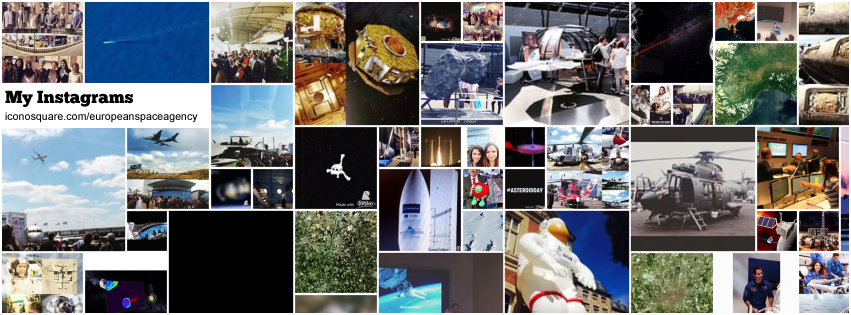Guest blog post by Carlota Maura James & Solène Esnoux
Over the last decade, social media has not only revolutionised the way we communicate, but also the way organisations all over the world share their goals and achievements to a broader audience. Instagram, a relatively new platform, was launched in 2010, acquired by Facebook in 2012 and is considered as one of the fastest growing social media of internet history. With over 300 million active users from all over the world, it has proven to be an indispensable instrument to reach younger audiences.
Instagram is based on an interactive and creative way of sharing photos and short videos by applying filters, and including emoji and hashtags to the captions. One of Instagram’s best features, which Facebook lacks, is that the use of hashtags enables users to ‘stumble’ upon ESA without having to explicitly look for it. Instagram is made unique by allowing followers to reach other users and even organisations with the simple use of tags and hashtags. Instagram allows to communicate directly with people all over the world instantly and in any way or language they desire.
ESA’s pre-existing account had approximately 600 followers without even a single photo posted. When we published the first photos, the number of followers started increasing rapidly and we even received welcoming messages from some of our followers. We published photos from ESA’s official web portal and Flickr account, related to the Agency’s missions, events and highlights of each week. During the week of the Paris Air & Space Show at Le Bourget, we went onsite and reported the event in its entirety by publishing photos of ESA’s pavilion and the general atmosphere at the show. We aimed to show the event differently from how it was depicted by ESA’s official photographs and channels by capturing a different perspective: The perspective of two young trainees discovering ESA as well as other Air & Space organisations and industry for the first time.
We soon started noticing some patterns in activity depending on the kind of content we published. Astronomy photos and artist views related to specific projects and missions such as launchers (Ariane 5 and 6), Earth observation satellites (Sentinel, Proba, etc), and especially the Rosetta mission (photos of comet 67P and the Philae lander) produced a lot of activity on the channel (likes and encouraging comments). We also found that posts relating to astronauts voyages’ in space attracted a significant increase in followers and activity on Instagram.
We realised that the age range for Instagram was between 12 and 25 years old. Most of our youngest followers were space enthusiasts with the dream of becoming astronauts, and others were already in space-related careers (engineers, physics majors, etc). However, we also found that some of our young followers didn’t display a particular interest in space science, which led us to understand that we were succeeding in attracting a broader audience that might have not been interested in ESA’s activities before discovering it on instragram. Knowing how young our audience on Instagram was, we used a specific register when writing the captions (jokes, exclamation marks, emoticons, hashtags), and a way of creating videos and image collages that would appeal to younger audiences (i.e. by epic soundtracks and movie motion). We took special care in using broad and generalised hashtags, such as #space, #universe, #science, #nature, or just #beauty, #photo and #awesome, to attract users that wouldn’t normally look for ESA’s account on Instagram.
We realised that photos relating to ESA’s corporate events and authorities weren’t very successful. Our followers were more interested in ESA’s missions and what the Agency actually does in space. Long, technical captions for the photos didn’t seem appropriate with regard to the general register that Instagram users expect and with the idea and language of Instagram, especially in communicating science in an easy, clear way.
Over the last month, our Instagram account has gained over 1,500 followers and we have published almost 100 photos and videos to promote ESA and inform the general public of the Agency’s missions. A presence in younger generation’s social media is of essence for the European Space Agency to become known across the world and to different audiences. Keeping up with social media trends is an indispensable communication strategy in the 21st century, and ESA must be at the forefront of this technological revolution.
Carlota Maura James and Solène Esnoux implemented this activity during their trainee assignment at ESA’s Communication Department, ESA Headquarters, Paris, France.


Discussion: one comment
Thanks for sharing your experience with Instagram, It’s inspiring and give us impulse to use new channels whilst communicating.